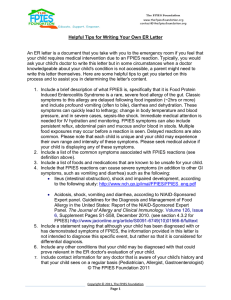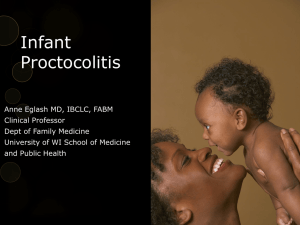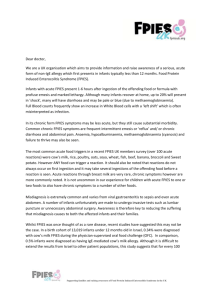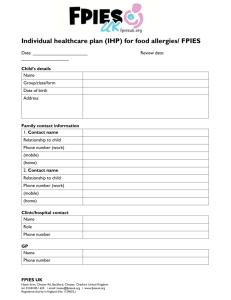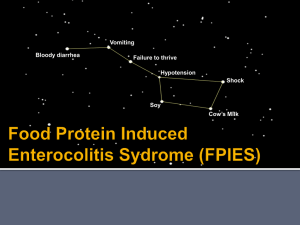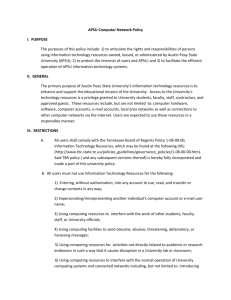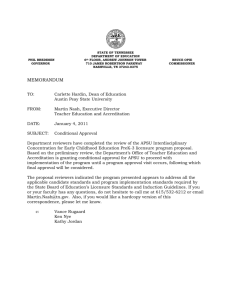Questionnaire - Australian Paediatric Surveillance Unit
advertisement
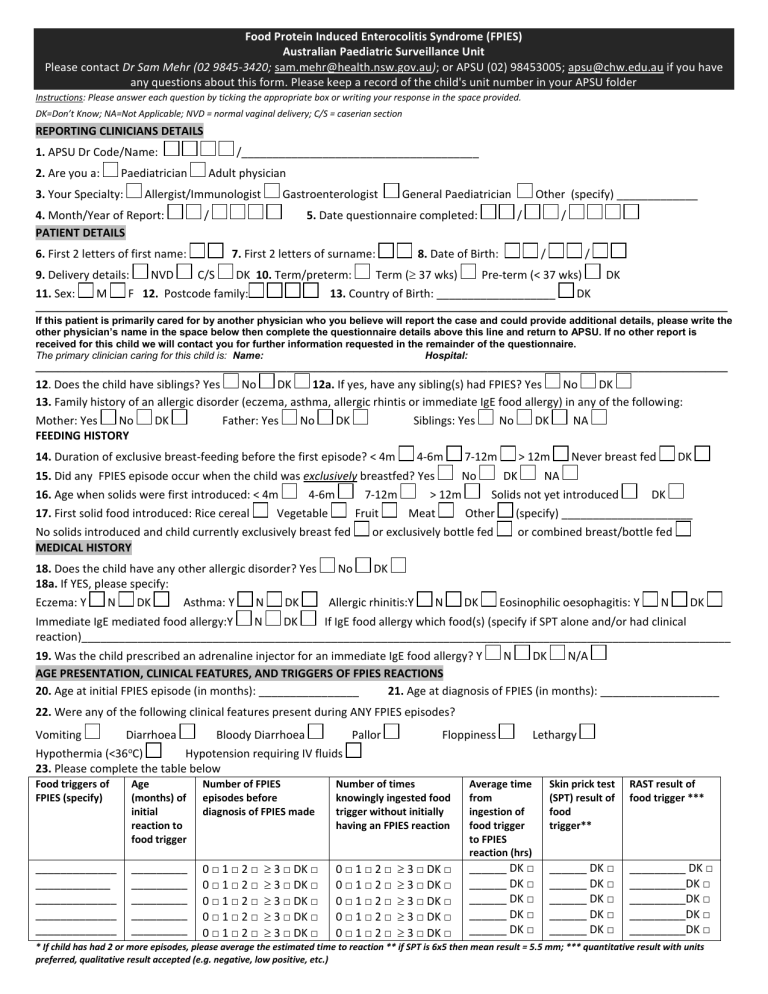
Food Protein Induced Enterocolitis Syndrome (FPIES) Australian Paediatric Surveillance Unit Please contact Dr Sam Mehr (02 9845-3420; sam.mehr@health.nsw.gov.au); or APSU (02) 98453005; apsu@chw.edu.au if you have any questions about this form. Please keep a record of the child's unit number in your APSU folder Instructions: Please answer each question by ticking the appropriate box or writing your response in the space provided. DK=Don’t Know; NA=Not Applicable; NVD = normal vaginal delivery; C/S = caserian section REPORTING CLINICIANS DETAILS 1. APSU Dr Code/Name: 2. Are you a: Paediatrician 3. Your Specialty: /______________________________________ Adult physician Allergist/Immunologist 4. Month/Year of Report: PATIENT DETAILS / 6. First 2 letters of first name: 9. Delivery details: 11. Sex: M NVD Gastroenterologist General Paediatrician 5. Date questionnaire completed: 7. First 2 letters of surname: C/S DK 10. Term/preterm: F 12. Postcode family: Other (specify) _____________ / / 8. Date of Birth: Term ( 37 wks) / / Pre-term (< 37 wks) 13. Country of Birth: ___________________ DK DK ____________________________________________________________________________________________________________________________ If this patient is primarily cared for by another physician who you believe will report the case and could provide additional details, please write the other physician’s name in the space below then complete the questionnaire details above this line and return to APSU. If no other report is received for this child we will contact you for further information requested in the remainder of the questionnaire. The primary clinician caring for this child is: Name: Hospital: ____________________________________________________________________________________________________________________________ 12. Does the child have siblings? Yes No DK 12a. If yes, have any sibling(s) had FPIES? Yes No DK 13. Family history of an allergic disorder (eczema, asthma, allergic rhintis or immediate IgE food allergy) in any of the following: Mother: Yes No DK Father: Yes No DK Siblings: Yes No DK NA FEEDING HISTORY 14. Duration of exclusive breast-feeding before the first episode? < 4m 4-6m 15. Did any FPIES episode occur when the child was exclusively breastfed? Yes 16. Age when solids were first introduced: < 4m 17. First solid food introduced: Rice cereal 4-6m 7-12m Vegetable Fruit No solids introduced and child currently exclusively breast fed MEDICAL HISTORY 7-12m No > 12m Meat DK Other N Never breast fed DK DK NA Solids not yet introduced or exclusively bottle fed 18. Does the child have any other allergic disorder? Yes No DK 18a. If YES, please specify: Eczema: Y N DK Asthma: Y N DK Allergic rhinitis:Y > 12m DK (specify) _____________________ or combined breast/bottle fed Eosinophilic oesophagitis: Y N DK Immediate IgE mediated food allergy:Y N DK If IgE food allergy which food(s) (specify if SPT alone and/or had clinical reaction)________________________________________________________________________________________________________ 19. Was the child prescribed an adrenaline injector for an immediate IgE food allergy? Y N DK N/A AGE PRESENTATION, CLINICAL FEATURES, AND TRIGGERS OF FPIES REACTIONS 20. Age at initial FPIES episode (in months): ________________ 21. Age at diagnosis of FPIES (in months): ___________________ 22. Were any of the following clinical features present during ANY FPIES episodes? Vomiting Diarrhoea Bloody Diarrhoea Pallor Floppiness Lethargy o Hypothermia (<36 C) Hypotension requiring IV fluids 23. Please complete the table below Food triggers of FPIES (specify) Age (months) of initial reaction to food trigger Number of FPIES episodes before diagnosis of FPIES made _____________ ____________ _____________ _____________ _____________ _________ _________ _________ _________ _________ 0□1□2□ 0□1□2□ 0□1□2□ 0□1□2□ 0□1□2□ 3 □ DK □ 3 □ DK □ 3 □ DK □ 3 □ DK □ 3 □ DK □ Number of times knowingly ingested food trigger without initially having an FPIES reaction Average time from ingestion of food trigger to FPIES reaction (hrs) Skin prick test (SPT) result of food trigger** RAST result of food trigger *** 3 □ DK □ 3 □ DK □ 3 □ DK □ 3 □ DK □ 3 □ DK □ ______ DK □ ______ DK □ ______ DK □ ______ DK □ ______ DK □ ______ DK □ ______ DK □ ______ DK □ ______ DK □ ______ DK □ _________ DK □ _________DK □ _________DK □ _________DK □ _________DK □ 0□1□2□ 0□1□2□ 0□1□2□ 0□1□2□ 0□1□2□ * If child has had 2 or more episodes, please average the estimated time to reaction ** if SPT is 6x5 then mean result = 5.5 mm; *** quantitative result with units preferred, qualitative result accepted (e.g. negative, low positive, etc.) FOODS INTRODUCED INTO DIET OF CHILD Please specify whether any of these foods/milk/formulas have been introduced Grains Rice Wheat Oat Rye Barley Corn Formulas/milk No formula and continue breast feeding Lactose free cow formula/milk Soy formula/milk Cow milk formula/milk Partial hydrolysed formula (e.g NAN-HA, etc) Extensive hydrolysed formula (e.g. Alfare, Pepti-J,etc) Amino acid formula (e.g Elecare, Neocate) Other solid foods Whole egg (egg white alone , or egg white + yolk) Baked egg products (e.g biscuit, cake, muffin) Baked milk products (e.g. biscuit, cake, muffin) Legumes (e.g. beans, lentils, peas) Sweet potato Fish Shellfish Poultry Banana Avocado Introduced? Y □ N □ DK □ Y □ N □ DK □ Y □ N □ DK □ Y □ N □ DK □ Y □ N □ DK □ Y □ N □ DK □ Age introduced (months) DK □ DK □ DK □ DK □ DK □ DK □ If introduced, FPIES reaction? Y □ N □ DK □ Y □ N □ DK □ Y □ N □ DK □ Y □ N □ DK □ Y □ N □ DK □ Y □ N □ DK □ Y□ Y□ Y□ Y□ Y□ Y□ Y□ N □ DK □ N □ DK □ N □ DK □ N □ DK □ N □ DK □ N □ DK □ N □ DK □ DK □ DK □ DK □ DK □ DK □ DK □ Y□ Y□ Y□ Y□ Y□ Y□ N □ DK □ N □ DK □ N □ DK □ N □ DK □ N □ DK □ N □ DK □ Y□ Y□ Y□ Y□ Y□ Y□ Y□ Y□ Y□ Y□ N □ DK □ N □ DK □ N □ DK □ N □ DK □ N □ DK □ N □ DK □ N □ DK □ N □ DK □ N □ DK □ N □ DK □ DK □ DK □ DK □ DK □ DK □ DK □ DK □ DK □ DK □ DK □ Y□ Y□ Y□ Y□ Y□ Y□ Y□ Y□ Y□ Y□ N □ DK □ N □ DK □ N □ DK □ N □ DK □ N □ DK □ N □ DK □ N □ DK □ N □ DK □ N □ DK □ N □ DK □ FEEDING ADVICE FOLLOWING DIAGNOSIS 24. Following diagnosis, which food(s) were recommended for exclusion or avoidance in the child’s diet? Causative food(s) only Other food(s) (please specify): _____________________________________________________ 25. Following diagnosis, were any food(s) excluded from the maternal diet if still breastfed? Causative food(s) Other food(s) (please specify): ____________________________________________________________ EMERGENCY DEPARTMENT (ED) VISITS AND INVESTIGATIONS 26. How many times did the child present to an emergency department with symptoms typical of FPIES prior to diagnosis? 0 1 2 3 4 5 5+ DK 27. Were any following interventions/investigations performed during any FPIES episode prior to diagnosis? Y Abdomimal U/S Gas enema Barium study Surgical consultation CT scan Operation MRI scan 28. Were any of the following identified during an episode of FPIES? Y Leukocytosis: Y N DK Neutrophilia: Y N EEG ECG (specify type) __________________ Other DK N DK Thrombocytosis: Y N DK NA IV antibiotics (specify): ___________________ NA N Metabolic acidosis: Y N DK Hypoglycaemia: Y N DK MANAGEMENT 29. Was an adrenaline injector provided for future emergency FPIES management? Y 30. Was a written emergency plan given in case of future FPIES reactions? Y N N DK DK DK 31. Did the child have a challenge to the causative food trigger(s) to support the diagnosis of FPIES? Y N DK If yes, how? Increasing incremental amounts (e.g given every 15-20 minutes) until a meal size portion consumed As a meal size portion of food given as a single, once off dose Other (please specify): _____________________________________________ DK Thank you for your help with this research project. Please return this questionnaire to the APSU in the reply-paid envelope or Fax to 02 98453082. Australian Paediatric Surveillance Unit, Kid’s Research Institute, Locked Bag 4001, Westmead NSW 2145 The Australian Paediatric Surveillance Unit is a unit of the Royal Australasian College of Physicians (Paediatrics and Child Health Division) and is funded by the NHMRC (Enabling Grant No. 402784 ); the Australian Government Department of Health and Ageing; and Sydney Medical School, University of Sydney. This study has been approved by a Human Research Ethics Committee properly constituted under NHMRC guidelines.
